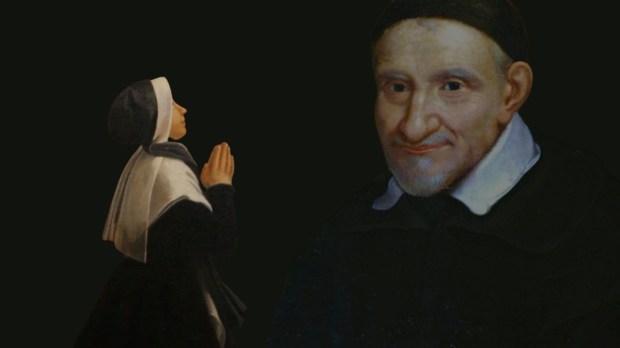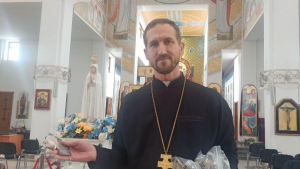The year 1824 was a difficult one for Zoé. (That’s what her family called her, preferring this name to the one she received at baptism). At 19 years old and the daughter of a wealthy farmer — Pierre Labouré of Fain-les-Moutiers in the Côte d’Or department of France — she knew that her father had marriage plans for her that would add to the family estate.
But Zoé didn’t want to marry. At the age of 12, she had already realized Christ would be the only love of her life, and she bound herself to Him by a vow of chastity. Her father was unaware of this and if he learned of it would be very unhappy.
Promised to the priesthood by his parents, Pierre Labouré — a Burgundian of high standing who didn’t have a vocation to ordained ministry — took advantage of the Revolution, which closed the seminaries, to escape the priesthood and to start a career as a local politician. These events also allowed him to marry a young girl from a much higher background than his own, whose family — a royalist one — had accepted the mismatch in order to secure a protector in republican circles.
Mr. Labouré became mayor of his village, a position he lost in 1815, just before his wife died, exhausted by 17 childbirths and the work with which her husband overburdened her.
Too heavy a burden
In such a case, it was the responsibility of the eldest daughter of the family to take over her mother’s place until her marriage. However, Marie-Louise, to whom this role belonged, refused to assume it for long. Raised in a bourgeois household by one of her maternal aunts, who had no children of her own and had practically adopted her, she hardly knew the family farm, nor her father and younger siblings. Above all, she had decided early on to enter the Daughters of Charity. She made no secret of the fact that, as soon as one of her sisters was old enough to run the house, she would leave.
This is how Zoé, the second daughter among the siblings, found herself at the age of 11 in charge of a vast farm, its numerous staff, the education of her younger brothers and sisters (of whom the youngest, Auguste, was disabled due an accident), and a tyrannical father whom she idolized.
Her habits of prayer, attending Mass (where she managed to go every day at dawn, undeterred by miles she had to walk because there was no longer a priest in her town), and the fasting she practiced in secret gave her the strength to carry a burden much too heavy for a little girl and fostered her religious vocation.
She never dared to speak about it to her agnostic father, who proclaimed from the rooftops that he had done enough by giving Marie-Louise to God. She knew that he wouldn’t let her go in turn. Her only hope was to wait until she came of age at 21, when she would be able to receive her share of her mother’s inheritance. With that, she would be able to afford the dowry demanded by religious congregations. In her mind – wrongly in fact – her problems seemed to be solved.
A bad idea
There were two other, more embarrassing problems. Pierre Labouré was too stingy to pay for his daughters’ education. He never considered it worthwhile to send his children to school and as a result Zoé could neither read nor write. She was even more ashamed of this because she had been told that no congregation would accept illiterate postulants. She had to remedy this deficit.
In addition, she didn’t know where God was calling her and, in spite of her prayers, had not received any sign that would enlighten her. Actually, this was not quite true. A few months earlier, she had had a strange dream. She saw herself at Mass at the church in Fain, which was closed. When the celebrant, an old man unknown to her, turned around, he looked at her with a smile of astonishing gentleness. His gaze sparkled with kindness and intelligence, and she was overwhelmed. In the next part of the dream, she saw herself at the bedside of a sick person, and the mysterious priest came in and said to her: “My daughter, it is good to look after the sick. Today you run away from me, but one day you’ll be happy to come to me. God has plans for you; don’t forget that.”
This dream continued to haunt her. Had it come from Heaven? Should she try to decipher it? But how? In the meantime, playing on her father’s snobbery and the fear of what people would say if they found out in the country that the little Labouré girls couldn’t read, Zoé got her father to enroll her with a cousin who was the director of a boarding school for young girls in Châtillon-sur-Seine.
This turned out to be a bad idea. The establishment educated the heiresses of the local high society, little girls much younger than Zoé who were very full of themselves. It didn’t take them long to choose “this peasant girl,” encumbered with a strong Burgundian accent and too gentle to defend herself, as the target of their bullying. Zoé’s daily life turned into an ordeal, and for nothing – because, in this hostile environment, she found herself incapable of learning anything.
The portrait of a priest
Once again, she found her only consolation in the church, in front of the Blessed Sacrament. The parish priest was an 83-year-old survivor of the persecutions of the Terror — Fr. Gailhac, formerly chaplain to the Daughters of Charity. When Zoé, who took him as a spiritual director, decided to tell him about her strange dream, he had no hesitation; he told her that St. Vincent de Paul was calling her.
The young girl opposed these words with polite reluctance. She knew the Daughters of Charity, and even had friends there, but felt no attraction to their charism. Besides, they had already received her sister Marie-Louise and she didn’t want to appear to be imitating her elder sister.
Fr. Gailhac was mistaken, she thought; or, like many former chaplains of women’s communities, he was directing the vocations he discovered to his favorite community. Zoé dismissed this possibility and didn’t mention it again. Months passed, bringing her closer to returning home and to reaching the age of independence.
One day, her cousin, to distract her from the nastiness of the other students, took her to visit the Daughters of Charity and there, in the parlor, was hanging the portrait of a priest. And not just any priest, but the one from her dream. Turning to the nun who had just entered, Zoé asked, “Sister, who is this priest?” And she replied, “Miss, he’s our father, St. Vincent de Paul!”
The house was in possession of one of the very few portraits painted during the founder’s lifetime. Zoé contemplated it. There was no doubt: it was he whom she had seen in her dream. He was waiting for her. And, since God had plans for her, that was where she had to go. It wouldn’t be easy, but young Catherine Labouré was stubborn. Grace would do the rest.



